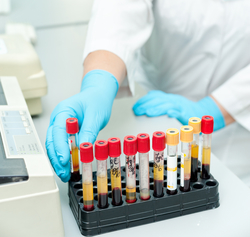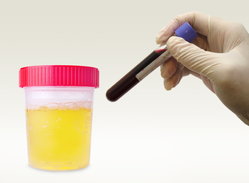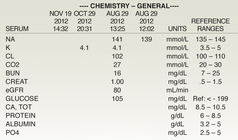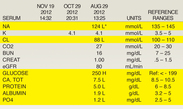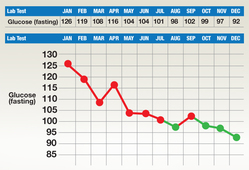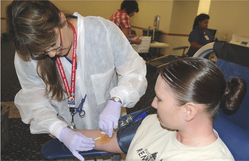Lab Tests Detect Kidney Disease
Kidney disease can be silent until a LOT of damage has been done. You can feel well but may still have a problem. How does your doctor know? Kidneys that don’t work well don’t remove as many wastes from your blood. These wastes—and other substances, like minerals and protein—can be measured in your blood or urine. These test results can tell your doctor if you have a problem.
Test Results Show Problems and Progress
Each blood or urine test has a “normal range.” If your levels are outside of the normal range, it means that you may have a health problem. Looking at which levels are outside of normal gives your care team clues about what to look for. You might want to check out the National Kidney Disease Education Program Kidney Test Results fact sheet*.
Watching the trends—how much your levels go up or down over time—tells your care team how quickly or slowly kidney disease is getting worse. If you have a kidney problem, your lab tests will help you know if your efforts and your care team’s are working to help slow the rate.
* Links will take you outside of the Department of Veterans Affairs website. VA does not endorse and is not responsible for the content of the linked websites.
Reading Your Test Results
Your blood test results tell you what’s going on inside your body. They can be a vital health clue that something is wrong, even if you feel well.
Your blood test results may look like this VA lab report (click on the image to enlarge).
Looking at the whole page may be confusing. You might be tempted to just skip it—but please don’t. Your blood test results are a tool that can help you track your health. Learning how to read and track them can help you feel more in control.
What to Look for in Lab Results
Try to look at just a few test results at a time. You can do this on your lab printout by covering up most of the page with a sheet of paper so you can focus on what you’re looking for.
You should see the name of the test, then the dates of your most recent tests with the results. A column labelled “Units” tells you how the test results are reported. Then, you’ll see a column labelled “Reference Ranges.” This tells you what the normal, healthy level is for each test. Now, you can look at your results to see if they are in the normal range.
Out-of-Range Results
On most lab test reports, any result that is outside of the normal range is marked with an asterisk, a comment, or a letter code to get attention.
In this example, MOST of the results are out of the normal range, so most have a letter code next to the test result. We’ve highlighted the “out-of-range” results in yellow so you can find them.
L means the result is lower than the normal range.
H means the result is higher than the normal range.
Look at glucose, for example. The result is 250 and it is labeled H—higher than the normal range. Click on the picture to enlarge the report so you can see it better.
Tracking Your Lab Results
Ask your care team for a copy of your lab results. You can use your results to get a better handle on how you are doing over time. There are two ways to do this. First, you can just keep a simple table with the results, as often as you get them. Or, you can GRAPH your lab tests so you can see the ups and downs. Here, we show results by month for a year. You can even color-code your results—red for out-of-range and green for values that are in the normal range.
The trends are just as important as the numbers you get. Are your numbers staying the same? Going up? Going down? Looking at the trends will help you see whether your actions to help slow your CKD are paying off.
Lab Tests and What They Mean
- If you feel fine, you can’t have a kidney problem:
Not scored Some people don’t know that they have a kidney problem until lab tests are done. The symptoms of kidney disease can be very subtle.
- Lab tests to tell if your kidneys are healthy are done on:
Not scored Kidneys remove wastes from the blood, so the blood is tested for wastes. Urine is tested to see if there is protein or blood in it.
- When you look at your lab test results, you want to see if they are in:
Not scored Lab print outs will tell you if each of your tests is in the normal range. If a result is above or below normal, talk with your care team.
- Which of these is a reason to track your own lab test results?
Not scored Tracking your lab tests can help you see if your efforts are paying off. It can also help you understand what your care team tells you, and follow your kidney health over time.
- You can track your lab test results by:
Not scored The trends in your results (whether each test is going up or down) are important, too. Writing down or graphing your results can help you see how your kidneys are doing.













